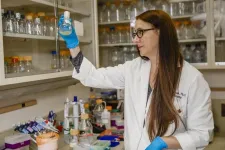The position statement reflects the consensus of two virtual roundtables the Endocrine Society held in 2022. Participants included representatives from the American College of Cardiology, American College of Physicians, American Diabetes Association®, Association of Diabetes Care & Education Specialists, Diabetes Technology Society, the U.S. Centers for Disease Control and Prevention, diabetes research organization dQ&A, and patient advocacy organizations DiabetesSisters, Close Concerns, and Taking Control of Your Diabetes.
More than 500 million people worldwide have diabetes, which occurs when the pancreas doesn’t make enough insulin or when the body isn’t able to respond to insulin properly, resulting in high levels of glucose in the blood (blood glucose). Managing this chronic disease requires making lifestyle changes throughout life, which can be burdensome for people living with diabetes and their caregivers. Daily tasks such as blood glucose monitoring, dietary and exercise management, routine preventive care scheduling, and medication management must be overseen by people living with diabetes themselves.
Effective two-way communication between people with diabetes and their health care providers helps establish a shared understanding of the treatment plan and goals. Health care providers who take the time to explain treatment options and discuss potential barriers can improve patient satisfaction and clinical outcomes. In addition, health care providers need to consider each individual patient’s level of health literacy and cultural background when discussing treatment options.
“Many existing educational resources are available to help health care providers think through ways they can discuss diabetes treatment in a neutral and nonjudgmental way and practice using those strategies,” said Rita R. Kalyani, M.D., M.H.S., Professor of Medicine in the Division of Endocrinology, Diabetes, & Metabolism at Johns Hopkins University School of Medicine, who chaired the position statement and represented the Endocrine Society during the consensus roundtables. “However, in the ever-changing landscape of diabetes and its management, both health care providers and people with diabetes will continue to need new and evolving tools to help address the common challenges they face.”
People with diabetes face an elevated risk of developing depression, anxiety, and other mental disorders. This makes understanding the psychosocial impact of diabetes important. Addressing stressors in the health care setting and ensuring timely mental health referrals, when appropriate, can help individuals with diabetes feel more comfortable and help them participate more fully in their appointments and care.
Each section in the position statement begins with a common clinical scenario that illustrates key gaps in diabetes care. Readily accessible graphics and tools that can be used by health care providers to deliver patient-centered care in practice are also included.
The position statement offers a framework for leveraging the experiences of people with diabetes to optimize health outcomes in several important areas, including:
Use of person-centered language in the health care setting Ensuring that referrals to diabetes self-management and support service programs are timely and accessible to all people with diabetes. Effectively navigating available therapeutic options together and explaining complex regimens to people with diabetes to encourage them to take medication as prescribed. Considering ways to adjust an individual’s treatment plan in a timely manner if they aren’t meeting therapeutic goals to prevent therapeutic inertia. Discussing strategies for assessment of hypoglycemia—low blood glucose episodes that can be dangerous—as well as prevention and treatment of hypoglycemia. Improving cardiovascular and renal outcomes using newer therapeutic options. Using telehealth in the appropriate clinical setting. Using and incorporating diabetes technologies such as insulin pumps and continuous glucose monitoring systems into the diabetes management plan, when appropriate.
The other authors of this study are Myriam Allende-Vigo of the University of Puerto Rico, Humacao, Puerto Rico, representing the American College of Physicians; Kellie Antinori-Lent of the University of Pittsburgh Medical Center Shadyside in Pittsburgh, Penn., representing Association of Diabetes Care & Education Specialists (ADCES); Kelly L. Close of Close Concerns, Inc., in San Francisco, Calif.; Sandeep R. Das of UT Southwestern Medical Center in Dallas, Texas, representing the American College of Cardiology; Phyllisa Deroze of dQ&A, The Diabetes Research Company in San Francisco, Calif., Steven Edelman of the University of California at San Diego in San Diego, Calif., representing Taking Control of Your Diabetes (TCOYD); Nuha A. El Sayed of the American Diabetes Association of Arlington, Va., and Harvard Medical School in Boston, Mass.; David Kerr of the Diabetes Technology Society in Santa Barbara, Calif.; Joshua J. Neumiller of Washington State University of Spokane, Wash., representing the American Diabetes Association; and Anna Norton, on behalf of DiabetesSisters of Raleigh, N.C.
The roundtable meetings were supported by educational grants to the Endocrine Society from Abbott, Medtronic, Novo Nordisk, and Vertex. The position statement, which is a summary of the findings from those consensus roundtables, was developed by the authors independently.
The manuscript, “Prioritizing Patient Experiences in the Management of Diabetes and Its Complications: An Endocrine Society Position Statement,” was published online.
# # #
Endocrinologists are at the core of solving the most pressing health problems of our time, from diabetes and obesity to infertility, bone health, and hormone-related cancers. The Endocrine Society is the world’s oldest and largest organization of scientists devoted to hormone research and physicians who care for people with hormone-related conditions.
The Society has more than 18,000 members, including scientists, physicians, educators, nurses and students in 122 countries. To learn more about the Society and the field of endocrinology, visit our site at www.endocrine.org. Follow us on Twitter at @TheEndoSociety and @EndoMedia.
END




